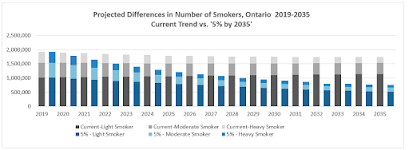The federal government has set the goal of reducing smoking rates in Canada to less than 5% by 2035. But are we on track to getting there? And are there economic benefits to governments and citizens if we do?
This summer, the Quebec Coalition for Tobacco Control and Physicians for a Smoke-Free Canada commissioned Dr. Hans Krueger to answer these questions. Dr. Krueger is a Canadian health economist who specializes in measuring the economic impact of health behaviours.
Dr. Krueger focused his efforts on Canada's two largest provinces, Ontario and Quebec. He found that if current trends continue, neither province would reduce smoking to 5% by 2035. Smoking rates are set to be twice as high -- 12.9% in Quebec and 11.5% in Ontario in 2035.
Should these provinces achieve a 5% prevalence rate by accelerating the current rate of decline there would be significant economic benefits. Dr. Krueger estimates that doing so would save Quebecers $22.2 billion and would save Ontarians $26.1 billion.
Current trends in smoking predict high future health care costs
Dr. Krueger used the Canadian Community Health Survey to analyze trends in smoking rates and intensity of smoking between 2000 and 2018. From these, he projected the current trends until 2035. As an alternative scenario, he estimated how many smokers there would be if these provinces were on track to reduce smoking to 5% by 2035. He calculated that reaching this national target would result in 990,000 fewer smokers in Ontario and 641,000 in Quebec.



